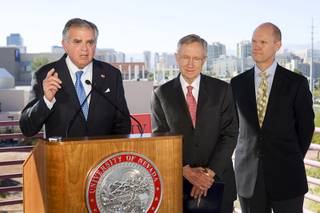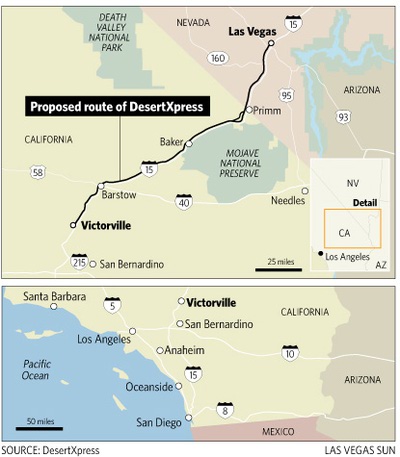
Andrew Mack, chief operating officer of DesertXpress Enterprises, stands behind a model of a proposed Victorville station during a news conference for the DesertXpress high-speed rail project Thursday, March 25, 2010.
Thursday, Feb. 10, 2011 | 2 a.m.
Sun archives
- Nevada seeks boost from proposed federal high-speed rail spending (2-9-2011)
- With new leaders, a revival of maglev high-speed rail? (11-25-2010)
- Harry Reid hopeful DesertXpress gets support from next governor (10-13-2010)
- Transportation secretary envisions nation connected by high-speed rail (10-13-2010)
- High-speed rail: Will it be worth the wait for Nevadans? (9-31-2010)
- DesertXpress likely further delayed by a federal agency (9-24-2010)
- Work on high-speed rail set to begin this year (3-25-2010)
- $45 million for maglev shifted to airport road project (3-17-2010)
- Backers of maglev train say Chinese bank prepared to fund project (2-3-2010)
- Maglev train backers woo contractors with promise of jobs (1-22-2010)
- DesertXpress prepared to build; maglev, monorail extension on hold (1-15-2010)
The Obama administration is trumpeting major new investments in high-speed rail beginning in the new fiscal year.
The sums aren’t enough to fully finance a high-speed rail system, but they are considerable: $53 billion over six years toward developing and laying track for a high-speed rail system the administration hopes will crisscross the country a quarter century from now.
The announcement is earning praise from several corners of the high-speed rail industry, including some who envision large developments for Nevada, one of the few places in the country that has broken ground on high-speed rail.
But before Nevadans get too excited about the administration’s new investment initiative, consider this: None of that money is likely headed to the Silver State.
In Nevada, the flagship high-speed rail venture is the DesertXpress, a line that, as currently planned, would connect Las Vegas to Victorville, Calif. — about an hour’s drive outside of the ultimate destination, Los Angeles.
It’s also a privately funded venture, and expects to remain so.
“We’re not considering any (federal grant) money at the present time,” said Lee Haney, a spokeswoman for DesertXpress, on Wednesday night.
At almost no point in the state’s short experiment with high-speed rail has a Nevada-based project been part of the federal grant funding equation, either because they were deemed ineligible — the case with the floated maglev project — or because they were, as in the case of DesertXpress, private ventures that never bothered applying for funds.
About a million dollars of stimulus money went to the Western High Speed Rail Alliance to help pay for feasibility studies, but those are projects that remain in the planning stages. DesertXpress managers have relied only on the government to furnish loan guarantees to attract investors.
Government grants could come in handy for the DesertXpress project. The plan that DesertXpress and the California high-speed rail authority have in place would eventually link the line from Victorville to Palmdale, Calif., and from there into the rest of the California high-speed rail system, once it is up and running. California has received the largest portion of federal grant dollars doled out for high-speed rail projects thus far.
But from Nevada’s perspective, the thing hampering high-speed rail development isn’t so much a guaranteed source of money as it is guaranteeing that its private venture will have a way to connect to the national grid.
While California’s rail authority is working with the DesertXpress team, DesertXpress is not the Golden State’s top priority project; a line connecting San Francisco to Los Angeles is. That’s its prerogative, as such funding is being funneled through the states’ agencies to pursue what priorities they see fit, with the help of federal dollars where they can match funds from state coffers.
That’s left those watching from Nevada’s side of the border unsure when high-speed rail will actually connect Las Vegas to another hub — and those time lines aren’t something the administration is addressing.
“We know of their plans, they know of our plans,” Transportation Secretary Ray LaHood said when asked about the Obama administration’s plans to urge more coordinated planning between private projects, like DesertXpress, and the administration’s other state-by-state investments. “It’s part of our plan ... they do not want to be disconnected.”
The administration’s plan is, in large part, to drum up enough enthusiasm for high-speed rail through investments and incentives that it will take off like the interstates did under Dwight Eisenhower; a vision it has tried to popularize with its mantra since the State of the Union address: “We do big things.”
But when connecting the dots between parts — like Las Vegas to Los Angeles — of those big things, the administration is, in many ways, punting the details to a Congress that has punted on the issue of transportation reform for years.
The U.S. High Speed Rail Association has estimated that building a truly interconnected national high-speed rail system is going to take a lot more than $53 billion: Its best guess is about $600 billion over 20 years.
That’s not a price tag many are willing to accept these days.
That wasn’t the case the past few years, when Democrats controlled the House, and the chief transportation guru was Rep. Jim Oberstar of Minnesota. He had spent the past several congressional cycles planning a $500 billion overhaul of the country’s surface transportation systems; a proposal that was strongly supported by his Republican counterpart, Rep. John Mica of Florida. Part of the bill they presented dealt with high-speed rail.
But since Mica graduated from ranking member to chairman, he’s been stepping away from his old stance. It’s not that Mica doesn’t still want an overhaul of national transportation, it’s just that when it comes to high-speed rail, he’s not so sure the government has the right approach — or should be footing the bill, especially during a recession.
“This is like giving Bernie Madoff another chance at handling your investment portfolio,” Mica said in a statement Tuesday, of the Obama administration’s pronouncements.
Through stimulus and other dollars, the Obama administration has already put $10.5 billion into high-speed rail projects; but the result, Mica says, has exposed more flaws in the system than it has bred confidence that the government should be investing more.
“What the administration touted as high-speed rail ended up as embarrassing snail-speed trains to nowhere,” Mica said, adding that the plan was too hinged to Amtrak’s “Soviet-style train system,” with 76 of 78 projects involving the heavily subsidized railroad monopoly on passenger rail.
Mica also called attention to the inefficiency of the Federal Railroad Administration — a division of the Transportation Department that is responsible for regulating passenger trains, but has focused throughout most of its history on policing freight.
Lobbyists and industry experts say the FRA does not appear to have been ready for the unprecedented push toward high-speed rail — making that agency ripe for overhauling once Congress turns its attention to transportation.
But that’s no short order in a Congress as split as this one. Even when Democrats controlled both houses of Congress and the White House, a bill to fund the country’s roads, rail lines, pipelines, and other transit networks proved impossible — meaning that the country hasn’t had a real long-term plan in any of those areas in place since 2009.
LaHood, though, is confident that a transportation bill can be completed by August.
But Democrats in Congress don’t sound quite as assured.
“Sen. Reid agrees with Secretary LaHood that surface transportation reauthorization legislation must be a high priority for the 112th Congress and hopes it can be achieved this year,” said a spokesman for Reid. “Not only will the legislation improve Nevada’s crumbling infrastructure, but it will create thousands of jobs and strengthen our economy.”




Join the Discussion:
Check this out for a full explanation of our conversion to the LiveFyre commenting system and instructions on how to sign up for an account.
Full comments policy